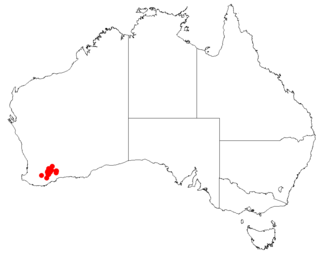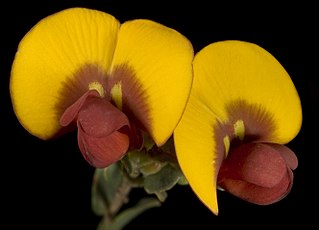
Bossiaea buxifolia, commonly known as matted bossiaea, is a species of flowering plant in the family Fabaceae and is endemic to south-eastern Australia. It is a prostrate to weakly erect shrub with elliptic to egg-shaped or almost round leaves and yellow, red and purplish flowers.

Bossiaea brownii is a species of flowering plant in the family Fabaceae and is endemic to eastern Queensland. It is an erect shrub with egg-shaped leaves and yellow flowers with red markings.

Bossiaea linophylla is a species of flowering plant in the family Fabaceae and is endemic to the south-west of Western Australia. It is a spreading shrub with linear to oblong or egg-shaped leaves, and bright yellow to orange or apricot-coloured and red flowers.

Bossiaea halophila is a species of flowering plant in the family Fabaceae and is endemic to Western Australia. It is a dense, erect, many-branched shrub with narrow-winged cladodes, leaves reduced to small scales, and yellow-orange and deep red flowers.
Bossiaea atrata is a species of flowering plant in the family Fabaceae and is endemic to the south-west of Western Australia. It is a dense, erect, spiny shrub with oblong to elliptic or almost round leaves, and orange-yellow and dark red flowers.
Bossiaea aurantiaca is a species of flowering plant in the family Fabaceae and is endemic to the south-west of Western Australia. It is a rounded or spreading, spiny shrub with oblong to narrow egg-shaped leaves, and golden-yellow and pinkish-red flowers.

Bossiaea concolor is a species of flowering plant in the family Fabaceae and is endemic to eastern Australia. It is an erect shrub with elliptic to oblong or egg-shaped leaves with the lower end towards the base, and yellow and red flowers.
Bossiaea cucullata is a species of flowering plant in the family Fabaceae and is endemic to Western Australia. It is a dense, many-branched shrub with narrow-winged cladodes, leaves reduced to dark brown scales, and yellow and deep red or pale greenish-yellow flowers.

Bossiaea disticha is a species of flowering plant in the family Fabaceae and is endemic to the far southwest of Western Australia. It is a weak, slender shrub with oblong to egg-shaped leaves and bright yellow and red flowers.
Bossiaea eremaea is a species of flowering plant in the family Fabaceae and is endemic to Western Australia. It is an openly-branched, spreading, more or less leafless shrub with deep yellow and purplish flowers.
Bossiaea flexuosa is a species of flowering plant in the family Fabaceae and is endemic to Western Australia. It is a compact shrub with slightly flattened, zigzag branches, notched, more or less leafless cladodes, and golden yellow and red or pinkish flowers.
Bossiaea inundata is a species of flowering plant in the family Fabaceae and is endemic to the Murchison River Gorge in Western Australia. It is a spreading, openly-branched shrub with oblong, elliptic or egg-shaped leaves with the narrower end towards the base, and deep yellow and red flowers.
Bossiaea laxa is a species of flowering plant in the family Fabaceae and is endemic to a small area near Norseman in Western Australia. It is a spreading, openly-branched shrub with linear to narrow oblong leaves, and bright yellow and red flowers.

Bossiaea neoanglica is a species of flowering plant in the family Fabaceae and is endemic to eastern Australia. It is a prostrate to low-lying shrub with sparsely hairy foliage, egg-shaped to more or less round leaves, and yellow and red flowers.
Bossiaea peninsularis is a species of flowering plant in the family Fabaceae and is endemic to the Eyre Peninsula in South Australia. It is an erect rhizome-forming, more or less leafless shrub with leaves reduced to small scales, and yellow, red and purplish flowers.
Bossiaea preissii is a species of flowering plant in the family Fabaceae and is endemic to the south of Western Australia. It is a compact, glabrous shrub with egg-shaped leaves with the narrower end towards the base, and yellow, red, orange or apricot-coloured flowers.

Bossiaea pulchella is a species of flowering plant in the family Fabaceae and is endemic to the south-west of Western Australia. It is a slender, erect shrub with egg-shaped leaves, and orange-yellow, purplish brown and dark red flowers.

Bossiaea rufa is a species of flowering plant in the family Fabaceae and is endemic to the south-west of Western Australia. It is a loose, many-branched shrub with elliptic to egg-shaped leaves with the narrower end towards the base, and deep yellow and red flowers.
Bossiaea saxosa is a species of flowering plant in the family Fabaceae and is endemic to a restricted area near Norseman, Western Australia. It is an erect, intricately branched shrub with many slightly flattened, sharply-pointed cladodes and deep yellow, red and lemon-yellow, pea-like flowers.
Bossiaea spinescens is a species of flowering plant in the family Fabaceae and is endemic to the south-west of Western Australia. It is a slender, spreading or compact, spiny shrub with oblong to oval leaves and yellow and reddish-brown, pea-like flowers.








